Colonel General Viktor Petrovich Goremykin, Deputy Minister of Defense of the Russian Federation and Chief of the Military-Political Main Directorate of the Russian Armed Forces chaired the event.
    |
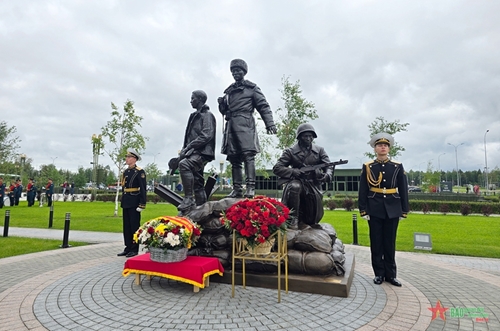 |
|
An overview of the monument |
The ceremony also saw the presence of Deputy Minister of Defense of Russia Colonel General Alexander Vasilyevich Fomin, Deputy Chief of the General Staff of the Vietnam People’s Army Sr. Lt. Gen. Phung Si Tan, and Vietnamese Ambassador to Russia Dang Minh Khoi.
In the 1930s, some patriotic Vietnamese youths, under the instruction of Nguyen Ai Quoc (later President Ho Chi Minh), studied in Moscow. When Nazi Germany attacked the Soviet Union, they voluntarily joined the international regiment of the independent motorized infantry brigade for special operations (OMSBON) under the Soviet Union’s Ministry of Internal Affairs. The regiment was tasked to guard key areas near the Kremlin.
    |
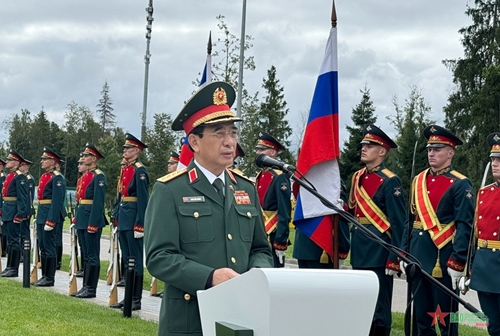 |
|
Gen. Phan Van Giang speaks at the inauguration ceremony. |
On November 7, 1941, they joined a historic parade on the Red Square and headed to the front. In the 1941-1942 winter, together with the Soviet troops and people, the Vietnamese volunteer soldiers bravely fought to repel the Nazi forces from Moscow. Three Vietnamese soldiers sacrificed their lives on the battlefield.
In 1986, the Presidium of the Supreme Soviet posthumously bestowed noble orders and medals on the Vietnamese soldiers.
The Russian Ministry of Defense asked the Vietnamese side to give comments on the sketch of the monument. The General Department of Political Affairs of the Vietnam People’s Army directed the Department of Political Education and Training to study the sketch and make report to the MND leadership for approval. Relevant agencies, units, and families of fallen Vietnamese soldiers provided images and documents for the Russian side through diplomatic channels.
    |
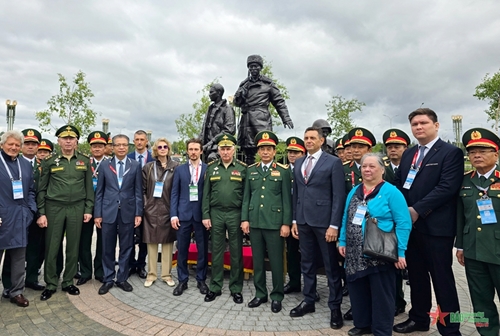 |
|
Gen. Giang, Col. Gen. Viktor Petrovich Goremykin, and other delegates in a group photo |
Thanks to the close coordination and agreement between the two sides and the construction of the Russian side, the monument was completed as scheduled.
Named “Allies - Vietnamese soldiers,” the monument is placed at Patriot Park in the suburb of Moscow. It consists of three bronze statues featuring three Vietnamese volunteer soldiers in defensive position fighting till their last breath to defend Moscow. The three statues are mounted on a pedestal depicting a defensive structure with anti-tank and bulletproof barriers.
The monument is a symbolic testament to the proletarian international spirit of the Vietnamese people and the time-honored solidarity and friendship between the peoples of Vietnam and Russia, and a reminder for the two peoples to always bear in mind the contribution of the heroes to the great victory, saving humanity from the fascist disaster.
Addressing the event, Gen. Giang emphasized that the Ministry of National Defense and the People’s Army of Vietnam highly appreciated and deeply thanked the Ministry of Defense and the Armed Forces of Russia for erecting this monument in Moscow.
He added that the monument in Moscow and the monument to Soviet-Russian and Vietnamese soldiers who sacrificed their lives for regional peace and stability in Vietnam’s Khanh Hoa province are a testament to the historical traditions and symbols of the great efforts to consolidate and deepen the comprehensive strategic partnership between the two countries.
He confirmed that over the past nearly 75 years, despite ups and downs of history and fluctuations in world and regional situations, the two peoples and militaries have cultivated, preserved and developed their fine traditional friendship in an intensive, effective and practical manner.
He expressed respect and gratitude to generations of the two countries’ leaders and people for developing bilateral friendship into the current comprehensive strategic partnership. He stressed that the people and military of Vietnam always bear in mind the great, effective and whole-hearted support that the Soviet Union and Russia gave to Vietnam in the past struggle for national reunification and the current Fatherland construction and defense cause.
For his part, Colonel General Viktor Petrovich Goremykin highlighted the Vietnamese volunteer soldiers’ engagement in the defense of Moscow against fierce attack of Nazi Germany. They bravely and resiliently stood side-by-side with the Red Army troops of the Soviet Union to dislodge the invaders, contributing to the victory of the Great Patriotic War. He expressed his respect to feats-of-arms of the Vietnamese volunteer troops and believed that the monument would help keep the historical memories of the Great Patriotic War and promote the cooperation and tighten the friendship between the two countries.
Also at the event, General Phan Van Giang inquired after Ms. Le Thi Phuong, daughter of soldier Ly Phu San (also known as Le Phan Chan), who is living in Moscow. The defense chief confirmed that the Party and State of Vietnam always pay attention to and have issued many policies for wounded and sick soldiers, martyrs’ families, policy beneficiary families, and national contributors and consider it an important and regular political task. He presented a national flag to Phuong, hoping that her family always look towards and have time to visit the homeland.
    |
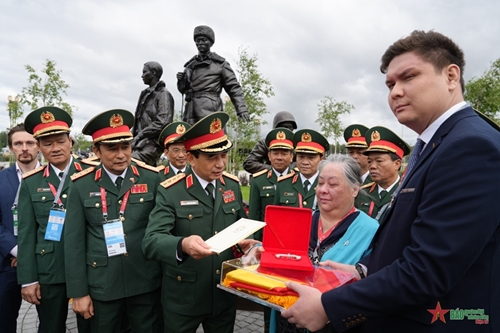 |
|
Gen. Giang presents the national flag to Ms. Le Thi Phuong |
On the morning the same day, Gen. Giang leading the Vietnamese delegation participated in the opening ceremony of the 10th International Military-Technical Forum ARMY-2024 in Moscow.
After that, the Vietnamese delegation toured booths at ARMY-2024 to learn about showcased products and exchange with exhibitors. He hailed and highly appreciated participating units and businesses.
    |
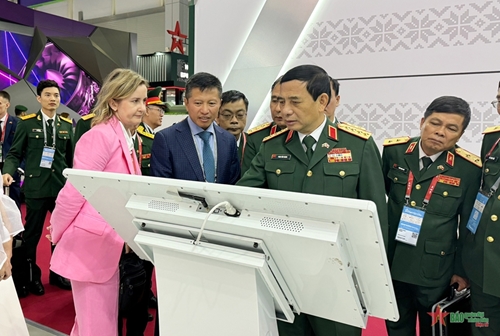 |
|
Gen. Giang and the entourage tour booths at ARMY-2024. |
ARMY is an annual event held by the Russian Ministry of Defense since 2015 at Patriot Exhibition-Convention Center in the suburb of Moscow. In this forum, a number of defense products in Russia and foreign countries are displayed.
By Thu Trang from Moscow, Russia
Translated by Mai Huong